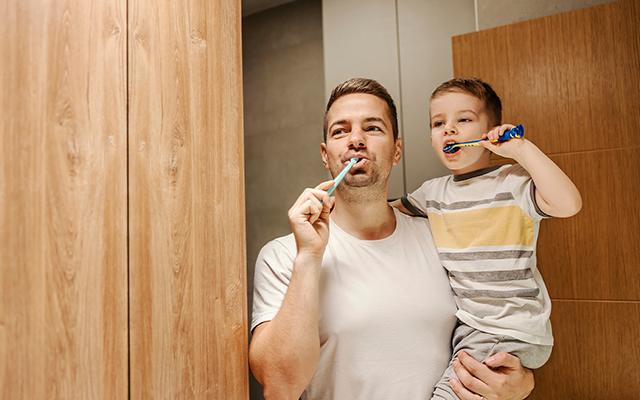What to expect when your baby starts teething
GEHA | August 22, 2022
What is teething?
Teething is the process in which teeth grow through the gums in an infant's mouth. Teething typically begins around 6 months of age, though some infants begin teething as early as 3 months while others don't begin until after 12 months. By the time your child is 30 months old, all twenty of their baby teeth should be in place.
Signs and symptoms that your baby may be teething
There are several signs and symptoms your baby may experience as they begin the teething process. If you know what to look for, you may even notice certain symptoms that signal the teething process will soon begin.
Common teething signs and symptoms include:
- Face rash
- Flushed cheeks
- Sucking fingers
- Excessive drooling
- Disruption of eating and sleeping patterns
- Acting cranky, irritable and tearful
- Low-grade fever
- Tender, swollen and sore gums
- Gnawing, chewing and biting objects
How to comfort your teething baby and care for their new teeth
As your baby begins teething, you will want to find ways to comfort your baby and care for their new teeth. There are several methods you can attempt for both.
To comfort your teething baby, you can:
- Rub your baby's gums. Wash your hands thoroughly, then massage or rub the sore area(s) with gentle finger pressure. You can also use clean and wet gauze instead of your finger.
- Keep their mouth cool. Cool or chilled food and objects can help soothe a baby's sore gums. You can place a cold spoon or teething ring (not frozen) on your baby's gums. If they are eating solids, you can use frozen bananas or berries. It is essential to watch your child closely when they have any substance in their mouth.
- Give your baby something to chew on. A firm, rubber teething ring may offer some pain relief.
- Try over-the-counter remedies. If nothing else is working and your baby seems especially upset, consider giving them infant's acetaminophen or ibuprofen.
To keep your baby's new teeth clean, you can:
- Run a soft, clean cloth over their gums twice a day. Once after the morning feeding and once before bed.
- Use a small, soft-bristled toothbrush to clean their teeth twice a day. A toothbrush should not be used until their first teeth appear.
- Use a smear of fluoride toothpaste no bigger than the size of a grain of rice. Once your child learns to spit (around ages 2–3) you can switch to a pea-sized dollop.
- Begin thinking about regular dental checkups. The American Dental Association and the American Academy of Pediatric Dentistry recommend scheduling a child's first dental visit around their first birthday.
What not to do
There are a few things to avoid while your baby is teething. Certain ingredients and tools will harm your child a lot more than they will help. To keep your baby safe, follow these guidelines:
- Avoid teething medications containing benzocaine or lidocaine. These ingredients can be harmful, even fatal to your baby.
- Avoid teething necklaces, bracelets or anklets. While amber teething necklaces and other similar products may be trendy, they pose a huge risk for choking and strangulation.
- Avoid liquid-filled teething rings.
- Never give your child aspirin.
- Do not rub alcohol on your baby's gums.
- Do not use homeopathic remedies.
- Never place anything frozen directly against your child’s gums or teeth. Instead, wrap the object in a towel or wait until it is cooler.
When to seek additional help
It is important to know that high fever, diarrhea and vomiting are not typical symptoms of teething and may be a sign that your child needs proper medical attention. If you notice your baby refusing food or bottles, it may also be time to contact their doctor. Click to access GEHA's Find Care tool.
Disclaimer: This information contained herein is for informational and educational purposes only. This information is not a substitute for professional medical advice and if you have questions regarding a medical condition, regimen, or treatment you should always seek the advice of a qualified health care provider. Never disregard or delay seeking medical advice from a qualified medical professional because of information you have read herein.
Sources:
“Baby teething symptoms.” www.nhs.uk, National Health Service, 1 February 2019
“Teething: Tips for soothing sore gums.” mayoclinic.org, Mayo Clinic, 25 February 2022
“Teething.” medlineplus.gov, National Library of Medicine, 2 October 2020
“Teething: 4 to 7 months.” www.healthychildren.org, American Academy of Pediatrics, 6 October 2016
“Frequently asked questions (FAQ).” www.aapd.org, America’s Pediatric Dentists, n.d.
“Safely soothing teething pain and sensory needs in babies and older Children.” www.fda.gov, U.S. Food and Drug Administration, n.d.
“Perinatal and infant oral health care.” www.aapd.org, America’s Pediatric Dentists, 2021
“Teething.” www.mouthhealthy.org, American Dental Association, n.d.
“Fact sheets for families – teething.” cchp.ucsf.edu, University of California San Francisco, 2005
“How to help teething symptoms without medications.” www.healthychildren.org, American Academy of Pediatrics, 27 March 2014
“Baby teething pain.” www.healthychildren.org, American Academy of Pediatrics, 20 December 2018
“Managing discomfort caused by teething.” www.jcda.ca, Canadian Dental Association, 5 December 2013











